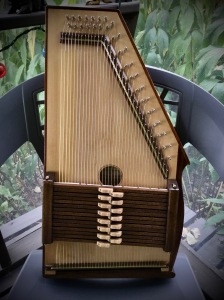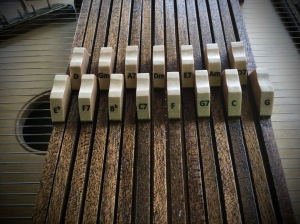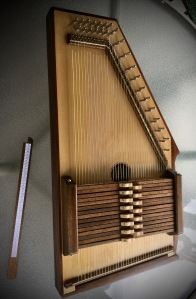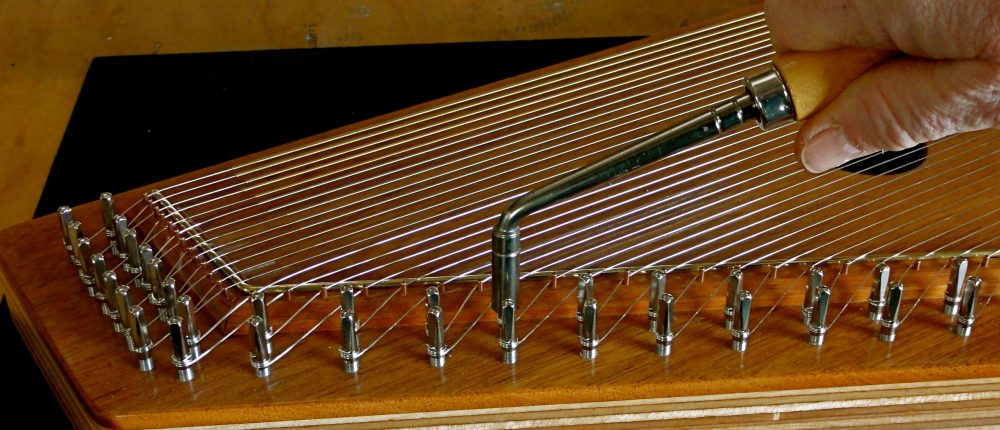The following is my article that was published in the 2019 summer edition of the Autoharp Quarterly magazine.
 I have always maintained my own instruments, mostly out of economic necessity but especially for the challenging DIY learning experience. This has led to a deeper understanding of what my instruments are capable of and how I might modify them to meet my personal needs. That has led to my forty plus years as a luthier, building and repairing a variety of stringed instruments.
I have always maintained my own instruments, mostly out of economic necessity but especially for the challenging DIY learning experience. This has led to a deeper understanding of what my instruments are capable of and how I might modify them to meet my personal needs. That has led to my forty plus years as a luthier, building and repairing a variety of stringed instruments.
My wife, Marsha, and I have always enjoyed autoharp music and began our own journey, as many do, by purchasing old autoharps on internet auctions. These needy ‘harps taught us tuning, restringing, and re-felting, but just as importantly, revealed design and aesthetic improvements that could benefit our musical experience. The next step (leap) in our journey was the decision to build our own using the many ideas we had gleaned from playing, observing, and “tinkering” with these wonderful instruments.
Have you reached this point in your journey? Building a box with strings on it is not as daunting as it may seem. If you possess the motivation, a little understanding of autoharps, some basic tools, and modest woodworking skills (or know someone who does) you too can build an autoharp to be proud of. Here are some ideas and resources to help you, the first time builder, get started.
Planning
Reverse engineering, or planning backwards, begins with ‘harps you can play or observe to determine the features you like. Take photos and accurate measurements. If you have access to a failed, unsalvageable ‘harp, trace a pattern and disassemble it to discover its acoustic and structural secrets or shortcomings.
Plans can offer specific direction or become a useful “jumping off point” for your own design. Included instructions illustrate the woodworking and assembly procedures involved.
 Plans for the Schmidt Model 73 are available for purchase from the Guild Of American Luthiers.
Plans for the Schmidt Model 73 are available for purchase from the Guild Of American Luthiers.
 Musicmakers offers a free download of plans and assembly instructions for their long discontinued “Autochord” kit and continues to sell the collated hardware to complete it. The Autochord differs somewhat in size and construction from other ‘harps but offers many helpful ideas. The file can be enlarged to full size at a retail copy center.
Musicmakers offers a free download of plans and assembly instructions for their long discontinued “Autochord” kit and continues to sell the collated hardware to complete it. The Autochord differs somewhat in size and construction from other ‘harps but offers many helpful ideas. The file can be enlarged to full size at a retail copy center.
 The Autoharp Owner’s Manual includes excellent plans and instructions for building “The Mountain Laurel Autoharp”, along with a wealth of maintenance and setup information. The design can support more chord bars, diatonic stringing schedules and aesthetic details. The plans can be photocopied and enlarged to full size at a retail copy center.
The Autoharp Owner’s Manual includes excellent plans and instructions for building “The Mountain Laurel Autoharp”, along with a wealth of maintenance and setup information. The design can support more chord bars, diatonic stringing schedules and aesthetic details. The plans can be photocopied and enlarged to full size at a retail copy center.
Materials
- Hardware stores stock the more common items such as screws, brass rod, glue, and finishing supplies.
- Specialized hardware such as zither and bridge pins can be purchased from online vendors or a piano supply company.
- Chord bar felt, OS parts, fine tuner assemblies, pickups, pins, springs, etc., can be purchased from many autoharp luthiers and Elderly Instruments.
- Standard and custom string sets are made by Greg Schreiber.
Wood
- Wood can be sourced from lumber yards, sawmills, local woodworkers, and online. If you cannot plane and sand solid woods for the thinner back and soundboard, consider the 1/4” marine and cabinet grade plywood sold in big box stores such as Lowe’s. They also stock 1/4” x 6” solid poplar that can be joined to produce a better soundboard than plywood. With some patience and careful sorting, you can often find attractive quarter sawn stock.
 The best framing material for tuning and overall stability is the multi-laminated maple pin block manufactured for pianos. It grips tuning pins without cracking and remains stable in changing environmental conditions. It is particularly effective when cut as a single unit for the angled treble side, as it eliminates a troublesome joint that wants to creep. I like to cut the entire frame from a single blank so that there are no joints to fail. Pin block can be obtained from a piano technician or piano supply but the planks are fifty-nine inches long, so it’s unlikely that they would sell only enough for one ‘harp. Contact me to purchase a more economical size.
The best framing material for tuning and overall stability is the multi-laminated maple pin block manufactured for pianos. It grips tuning pins without cracking and remains stable in changing environmental conditions. It is particularly effective when cut as a single unit for the angled treble side, as it eliminates a troublesome joint that wants to creep. I like to cut the entire frame from a single blank so that there are no joints to fail. Pin block can be obtained from a piano technician or piano supply but the planks are fifty-nine inches long, so it’s unlikely that they would sell only enough for one ‘harp. Contact me to purchase a more economical size.
In closing
When you create your own special box with strings, not only do you increase your knowledge and skills of everything autoharp, but also you get a warm fuzzy rush every time someone asks, “Who made your autoharp?”
Links
Plans
The Guild Of American Luthiers: http://www.luth.org
Musicmakers : https://www.harpkit.com
The Autoharp Owner’s Manual compiled and edited by Mary Lou Orthey is available from Daigle Autoharps: http://www.daigleharp.com
Materials
Schaff Piano Supply (wholesale) https://www.schaffpiano.com
Vanda King (retail piano supply): https://www.vandaking.com
Elderly Instruments: https://www.elderly.com
Greg Schreiber: http://schreiberautoharps.com
Michael Bowman: https://fretorfretnot.com
 A musician from Tennessee recently commissioned this custom autoharp with several features that, to me, are very similar to the fifteen chord Oscar Schmidt and ChromaHarp models of the past. Over the years those A style chromatic models with their round sound holes, fifteen chord bars in two rows, and laminated soundboards underwent many improvements by their manufacturers. This musician seems to favor that style of instrument and was able to specify several construction, setup, and cosmetic improvements to suit his preferences and playing style.
A musician from Tennessee recently commissioned this custom autoharp with several features that, to me, are very similar to the fifteen chord Oscar Schmidt and ChromaHarp models of the past. Over the years those A style chromatic models with their round sound holes, fifteen chord bars in two rows, and laminated soundboards underwent many improvements by their manufacturers. This musician seems to favor that style of instrument and was able to specify several construction, setup, and cosmetic improvements to suit his preferences and playing style. Most of my builds have been set up for playing in the area above the chord bars with the high treble strings unobstructed by the chord bar covers. This chord set is positioned closer to the tuning pins to permit play below the chord bars at the anchor end. Many of the old OS A models were arranged this way until playing the instrument upright became common and the bar set was moved south by their owners or the factories. This instrument is designed to be played on the musician’s lap with the left hand at the chords and the right hand playing near the anchor bridge.
Most of my builds have been set up for playing in the area above the chord bars with the high treble strings unobstructed by the chord bar covers. This chord set is positioned closer to the tuning pins to permit play below the chord bars at the anchor end. Many of the old OS A models were arranged this way until playing the instrument upright became common and the bar set was moved south by their owners or the factories. This instrument is designed to be played on the musician’s lap with the left hand at the chords and the right hand playing near the anchor bridge. The old A models chord bars and buttons were 5/16 inches wide. I reduced these bars to a 1/4 inch width to narrow the array while leaving the buttons wide enough as to not require caps. The maple buttons are of a similar style to the older fifteen chord ‘harps and the chords are selected and arranged to the musician’s preference. He prefers a higher action (the height of the felt above the strings) for more vigorous chording. I set the travel high as requested but included extra self-sticking felt strips for under the covers should he choose to adjust the bars lower.
The old A models chord bars and buttons were 5/16 inches wide. I reduced these bars to a 1/4 inch width to narrow the array while leaving the buttons wide enough as to not require caps. The maple buttons are of a similar style to the older fifteen chord ‘harps and the chords are selected and arranged to the musician’s preference. He prefers a higher action (the height of the felt above the strings) for more vigorous chording. I set the travel high as requested but included extra self-sticking felt strips for under the covers should he choose to adjust the bars lower. The modern improvements in the construction of this instrument include a solid spruce soundboard with tuned bracing, a one piece laminated frame, and quiet chord bars mounted on Delrin and steel pin combs. The chord bars, covers, side veneer, bridges, and tailpiece are made of African mahogany that has been stained dark brown. The musician requested that I not apply note labels under the tuning pins so I included a wooden tuning strip/duster that can be positioned under the strings to aid tuning.
The modern improvements in the construction of this instrument include a solid spruce soundboard with tuned bracing, a one piece laminated frame, and quiet chord bars mounted on Delrin and steel pin combs. The chord bars, covers, side veneer, bridges, and tailpiece are made of African mahogany that has been stained dark brown. The musician requested that I not apply note labels under the tuning pins so I included a wooden tuning strip/duster that can be positioned under the strings to aid tuning. A custom built autoharp such as this can be built with the preferred features and options that improve playability and appearance. Sometimes it comes with a surprise: as the owner noted, “I was in shock at how light it is!”.
A custom built autoharp such as this can be built with the preferred features and options that improve playability and appearance. Sometimes it comes with a surprise: as the owner noted, “I was in shock at how light it is!”.
 I have always maintained my own instruments, mostly out of economic necessity but especially for the challenging DIY learning experience. This has led to a deeper understanding of what my instruments are capable of and how I might modify them to meet my personal needs. That has led to my forty plus years as a luthier, building and repairing a variety of stringed instruments.
I have always maintained my own instruments, mostly out of economic necessity but especially for the challenging DIY learning experience. This has led to a deeper understanding of what my instruments are capable of and how I might modify them to meet my personal needs. That has led to my forty plus years as a luthier, building and repairing a variety of stringed instruments. Plans for the Schmidt Model 73 are available for purchase from the Guild Of American Luthiers.
Plans for the Schmidt Model 73 are available for purchase from the Guild Of American Luthiers. Musicmakers offers a free download of plans and assembly instructions for their long discontinued “Autochord” kit and continues to sell the collated hardware to complete it. The Autochord differs somewhat in size and construction from other ‘harps but offers many helpful ideas. The file can be enlarged to full size at a retail copy center.
Musicmakers offers a free download of plans and assembly instructions for their long discontinued “Autochord” kit and continues to sell the collated hardware to complete it. The Autochord differs somewhat in size and construction from other ‘harps but offers many helpful ideas. The file can be enlarged to full size at a retail copy center. The Autoharp Owner’s Manual includes excellent plans and instructions for building
The Autoharp Owner’s Manual includes excellent plans and instructions for building The best framing material for tuning and overall stability is the multi-laminated maple pin block manufactured for pianos. It grips tuning pins without cracking and remains stable in changing environmental conditions. It is particularly effective when cut as a single unit for the angled treble side, as it eliminates a troublesome joint that wants to creep. I like to cut the entire frame from a single blank so that there are no joints to fail. Pin block can be obtained from a piano technician or piano supply but the planks are fifty-nine inches long, so it’s unlikely that they would sell only enough for one ‘harp. Contact me to purchase a more economical size.
The best framing material for tuning and overall stability is the multi-laminated maple pin block manufactured for pianos. It grips tuning pins without cracking and remains stable in changing environmental conditions. It is particularly effective when cut as a single unit for the angled treble side, as it eliminates a troublesome joint that wants to creep. I like to cut the entire frame from a single blank so that there are no joints to fail. Pin block can be obtained from a piano technician or piano supply but the planks are fifty-nine inches long, so it’s unlikely that they would sell only enough for one ‘harp. Contact me to purchase a more economical size.
You must be logged in to post a comment.